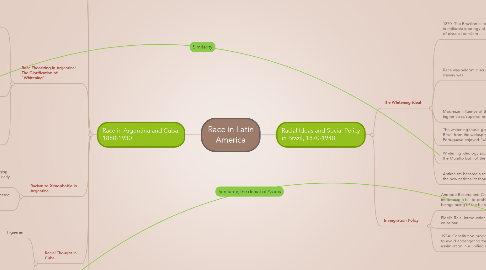
1. Race in Argentina and Cuba, 1880-1930
1.1. In Hispanic America, the elite was the Creole who was viewed superior compared to Indian, Black, Mestizo, or Mulatto
1.2. Racial issues pervaded numerous essays in Hispanic America which lead to Indian "problem," black "question," and the consequences of cross breeding/possible emergence of a new Latin American race
1.3. Race Theorizing in Argentina: The Glorification of "Whitening"
1.3.1. Domingo Sarmiento
1.3.1.1. evolutionary vision of race and faith in immigration and education as the solution to Argentina's problems
1.3.1.2. Anglo Saxon and Christians of the US are the most civilized
1.3.1.3. education not excluded in inferior races because the progress of intelligence is sure and failing in all of them, even the most backward
1.3.1.4. Blacks progress more than Indians
1.3.2. Octavia Bune, Nuestra America
1.3.2.1. global analysis of race
1.3.2.2. proposed education, cultural Europeanization, and hard work
1.3.2.3. Also believed that Blacks progressed more than Indians
1.3.3. Jose Ingenieros
1.3.3.1. stood for coherent and intransigent racial evolutionism in Argentina and believed in the theory of "biogenetical correlation" between environment, climate, race, and institutions
1.3.3.2. Natural selection to affirm colored races are inferior therefore race would disappear due to struggle
1.4. Racism to Xenophobia in Argentina
1.4.1. Indians were considered the most challenging enemy of Argentinean civilization until the early 1880s
1.4.1.1. 1890, Argentina's Indians had either been killed or enslaved
1.4.2. 1900: Argentina nationalism was created through nationalist education and xenophobia
1.4.2.1. Education was the only way for rural areas and immigrants to ingrate to be true Argentinians
1.5. Racial Thought in Cuba
1.5.1. Figueras
1.5.1.1. Proved racial incapacity to form an independent republic
1.5.1.2. Natural selection would would lead to the absorption of blacks by superior race
1.5.2. Ortiz
1.5.2.1. Integrate the criminology with racial theory to focus on cultural manifestations of races rather than on their physical feature
1.5.2.2. Proposed the elimination of the manifestations of African culture as stereotyped
1.6. White Policies and Black Responses
1.6.1. Policies segregated Creole from other races; Creole viewed as superior
1.6.2. Prohibit Chinese immigration
2. Racial Ideas and Social Policy in Brazil, 1870-1940
2.1. The Whitening Ideal
2.1.1. 1870: The Brazilian elite came to accept an identifiable ideology of development-- a form of classic liberalism
2.1.2. Race was seldom discussed by slavery was
2.1.2.1. (1) No one believed in biological inferiority
2.1.2.2. (2) Abolitionists did worry about the large unskilled mass representation of slaves
2.1.2.2.1. European immigrants as the solution of post abolition labor problems
2.1.2.3. (3) Abolitionists believed miscegenation would gradually and inexorably "whiten" and thereby "upgrade" the Brazilian population
2.1.3. Maximize influence of the higher class/superior race
2.1.4. The whitening thesis got unique support in Brazil from the widespread belief that the Portuguese enjoyed "whitening" dark people
2.1.5. Whitening ideology accepted the Mulatto but not the Blacks
2.1.6. Antiracism became a tenet of the new nationalist thought
2.1.6.1. Alberto Torres: Created a nationalist position after refute of white superiority
2.2. Immigration Policy
2.2.1. Andrade Bezerra and Cincinnato Braga introduced a bill to prohibit entry of "human beings being of the black race"
2.2.2. Fidelis Reis, introduction of the color bar
2.2.2.1. Asians viewed as a "yellow cyst"
2.2.3. 1934: Constitution proposed by congressmen to avoid endangering the steady process of assimilation in a unified society
